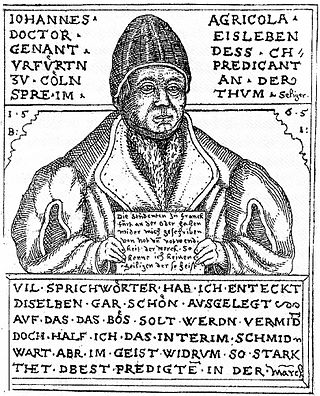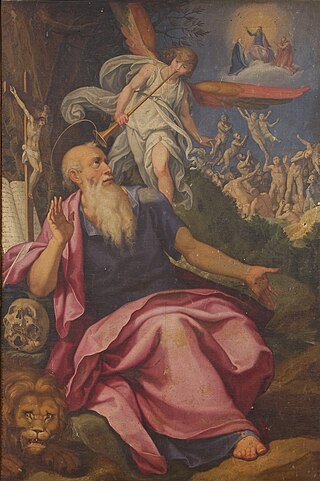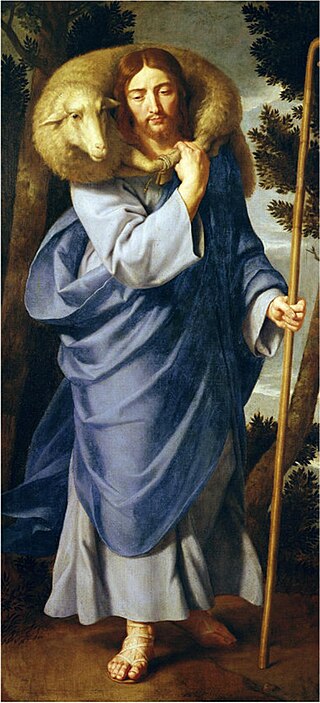Related Research Articles
The Bach-Werke-Verzeichnis is a catalogue of compositions by Johann Sebastian Bach. It was first published in 1950, edited by Wolfgang Schmieder. The catalogue's second edition appeared in 1990. An abbreviated version of that second edition, known as BWV2a, was published in 1998.

Liebster Gott, wenn werd ich sterben?, BWV 8, is a church cantata for the 16th Sunday after Trinity by Johann Sebastian Bach. It is a chorale cantata, part of Bach's second cantata cycle. Bach performed it for the first time on 24 September 1724 in St. Nicholas Church in Leipzig. The cantata is scored for SATB singers, four wind instruments, strings and continuo.
Throughout his life as a musician, Johann Sebastian Bach composed cantatas for both secular and sacred use. His church cantatas are cantatas which he composed for use in the Lutheran church, mainly intended for the occasions of the liturgical year.

Sechs Chorale von verschiedener Art: auf einer Orgel mit 2 Clavieren und Pedal vorzuspielen, commonly known as the Schübler Chorales, BWV 645–650, is a set of chorale preludes composed by Johann Sebastian Bach. Johann Georg Schübler, after whom the collection came to be named, published it in 1747 or before August 1748, in Zella St. Blasii. At least five preludes of the compilation are transcribed from movements in Bach's church cantatas, mostly chorale cantatas he had composed around two decades earlier.
Johann Sebastian Bach composed the church cantata Wär Gott nicht mit uns diese Zeit, BWV 14, in Leipzig in 1735 for the fourth Sunday after Epiphany and first performed it on 30 January 1735, a few weeks after his Christmas Oratorio. The cantata, in Bach's chorale cantata format, is based on Martin Luther's hymn "Wär Gott nicht mit uns diese Zeit". Its text paraphrases Psalm 124, focussing on the thought that the believers' life depends on God's help and is lost without it.

The cantatas composed by Johann Sebastian Bach, known as Bach cantatas, are a body of work consisting of over 200 surviving independent works, and at least several dozen that are considered lost. As far as known, Bach's earliest cantatas date from 1707, the year he moved to Mühlhausen, although he may have begun composing them at his previous post in Arnstadt. Most of Bach's church cantatas date from his first years as Thomaskantor and director of church music in Leipzig, a position which he took up in 1723.

"Ach Gott, wie manches Herzeleid" is a hymn in German in 18 stanzas attributed to Martin Moller (1587). It is often catalogued as a paraphrase of the Latin "Jesu dulcis memoria", a medieval hymn attributed to Bernard of Clairvaux, but only a few lines refer directly to this song. Hymn tunes were composed for the hymn, and it is also often sung to a tune composed for "Herr Jesu Christ, meins Lebens Licht". The anonymous hymn tune of "Herr Jesu Christ, meins Lebens Licht" first appeared in Wolflein Lochamer's Lochamer-Liederbuch, printed in Nürnberg around 1455. In Leipzig in the 1720s, Johann Sebastian Bach composed settings of Lochamer's hymn based on four of his church cantatas and a sacred motet.

Johann Sebastian Bach composed the church cantata Ich ruf zu dir, Herr Jesu Christ, BWV 177. He wrote the chorale cantata in Leipzig for the fourth Sunday after Trinity and first performed it on 6 July 1732. The cantata text is formed by the unchanged five stanzas of Johann Agricola's hymn.

Johann Sebastian Bach composed the church cantata Nimm von uns, Herr, du treuer Gott, BWV 101, in Leipzig for the tenth Sunday after Trinity and first performed it on 13 August 1724. It is based on the seven stanzas of the hymn of the same name by Martin Moller (1584), which is sung to the tune of "Vater unser im Himmelreich", Luther's metred paraphrase of the Lord's Prayer. The tune is featured prominently in six of the work's seven movements.

Herr Jesu Christ, wahr' Mensch und Gott, BWV 127, is a cantata by Johann Sebastian Bach for use in a Lutheran service. He composed the chorale cantata in 1725 in Leipzig for the Sunday Estomihi, the Sunday before Lent. It is based on Paul Eber's 1582 hymn in eight stanzas "Herr Jesu Christ, wahr Mensch und Gott". Bach first performed it on 11 February 1725.
There are 52 chorale cantatas by Johann Sebastian Bach surviving in at least one complete version. Around 40 of these were composed during his second year as Thomaskantor in Leipzig, which started after Trinity Sunday 4 June 1724, and form the backbone of his chorale cantata cycle. The eldest known cantata by Bach, an early version of Christ lag in Todes Banden, BWV 4, presumably written in 1707, was a chorale cantata. The last chorale cantata he wrote in his second year in Leipzig was Wie schön leuchtet der Morgenstern, BWV 1, first performed on Palm Sunday, 25 March 1725. In the ten years after that he wrote at least a dozen further chorale cantatas and other cantatas that were added to his chorale cantata cycle.

Johann Sebastian Bach composed the church cantata Ach, lieben Christen, seid getrost, BWV 114, in Leipzig for the 17th Sunday after Trinity and first performed it on 1 October 1724. It is based on on a 1561 hymn of penitence by Johannes Gigas. Its tune is featured in three of the work's seven movements.

Der Herr ist mein getreuer Hirt, BWV 112, is a cantata by Johann Sebastian Bach, a church cantata for the second Sunday after Easter. Bach composed the chorale cantata in Leipzig and first performed it on 8 April 1731. It is based on the hymn by Wolfgang Meuslin, a paraphrase of Psalm 23 written in 1530, sung to a melody by Nikolaus Decius.
In Johann Sebastian Bach's time, the election or inauguration of a new town council, normally an annual event, was celebrated with a church service. A cantata written for such occasion was indicated with the term Ratswahl or Ratswechsel. Bach composed such cantatas for Mühlhausen and for Leipzig. Five of these cantatas are entirely extant. One further cantata, BWV 193.2, lost part of its music, and there are another five that have only been known to exist, or for which only the text is extant.
Bach's first cantata cycle refers to the church cantatas Johann Sebastian Bach composed for the somewhat less than 60 occasions of the liturgical year of his first year as Thomaskantor in Leipzig which required concerted music. That year ran from the first Sunday after Trinity in 1723 to Trinity Sunday of the next year:
Picander's cycle of 1728–29 is a cycle of church cantata librettos covering the liturgical year. It was published for the first time in 1728 as Cantaten auf die Sonn- und Fest-Tage durch das gantze Jahr. Johann Sebastian Bach set several of these librettos to music, but it is unknown whether he covered a substantial part of the cycle. This elusive cycle of cantata settings is indicated as the composer's fourth Leipzig cycle, or the Picander cycle.

On Trinity Sunday 27 May 1725 Johann Sebastian Bach had presented the last cantata of his second cantata cycle, the cycle which coincided with his second year in Leipzig. As director musices of the principal churches in Leipzig he presented a variety of cantatas over the next three years. New cantatas for occasions of the liturgical year composed in this period, except for a few in the chorale cantata format, are known as Bach's third cantata cycle. His next cycle of church cantatas, the Picander cycle, did not start before St. John's Day 24 June 1728.
The late church cantatas by Johann Sebastian Bach are sacred cantatas he composed after his fourth cycle of 1728–29. Whether Bach still composed a full cantata cycle in the last 20 years of his life is not known, but the extant cantatas of this period written for occasions of the liturgical year are sometimes referred to as his fifth cycle, as, according to his obituary, he would have written five such cycles – inasmuch as such cantatas were not late additions to earlier cycles, or were adopted in his oratorios.
References
- 1 2 3 4 Hofmann, Klaus (2002). "O Ewigkeit, du Donnerwort, BWV 20 / O eternity, thou thunderous word" (PDF). bach-cantatas.com. p. 5. Retrieved 5 June 2012.
- 1 2 Philippe (and Gérard) Zwang. Guide pratique des cantates de Bach. Paris, 1982. ISBN 2-221-00749-2. See Johann Sebastian Bach: Correspondance Catalogues Zwang — Schmeider at www
.musiqueorguequebec .ca - 1 2 3 4 5 6 7 8 9 10 11 12 13 14 15 16 17 Günther Zedler. Die Kantaten von Johann Sebastian Bach: Eine Einführung in die Werkgattung. Books on Demand, 2011. ISBN 9783842357259, p. 32–37
- 1 2 3 4 5 6 7 8 Alfred Dörffel. Bach-Gesellschaft Ausgabe Volume 27: Thematisches Verzeichniss der Kirchencantaten No. 1–120 . Breitkopf & Härtel, 1878. Introduction, pp. V–IX
- ↑ John Eliot Gardiner (2004). "Cantatas for the First Sunday after Trinity / St Giles Cripplegate, London" (PDF). bach-cantatas.com. p. 2. Retrieved 5 June 2012.
- 1 2 3 4 5 6 7 Alfred Dürr, translated by Richard D. P. Jones. "6. The Reformation Festival: BWV 80, 79", pp. 707–714 in Part II: Church Cantatas of The Cantatas of J. S. Bach: With Their Librettos in German-English Parallel Text. Oxford: OUP, 2006. ISBN 0199297762
- ↑ Work 00100 at Bach Digital website (09/03/2017)
- 1 2 3 Work 00101 (17/6/2017), and subsequent manuscript pages F-Ppo A. Mickiewicz Rkp. 973 (23/6/2017), RUS-SPsc BWV 80b (26/7/2017) and US-PRscheide BWV 80b (19/7/2017), at Bach Digital website
- ↑ Christoph Wolff. "The Reformation Cantata Ein feste Burg", pp 152–161 in Bach: Essays on His Life and Music. Harvard University Press, 1991. ISBN 0674059263
- ↑ Work 00198 at Bach Digital website (10/03/2017)
- 1 2 3 Work 00099 at Bach Digital website (19/07/2017)
- ↑ Work 00098 at Bach Digital website (18/07/2017)
- 1 2 Philipp Spitta, translated by Clara Bell and J. A. Fuller Maitland. Book V: The Final Period of Bach's Life and Work, Chapter III: "The later Chorale Cantatas" pp. 64–108 in Johann Sebastian Bach: His Work and Influence on the Music of Germany, 1685–1750 Volume 3. Novello & Co. 1884–1885.
- ↑ Reginald Lane Poole. Sebastian Bach. London: Sampson Low, Marston, Searle, & Rivington. 1882, p. 133
- ↑ Johann Nikolaus Forkel translated with notes and appendices by Charles Sanford Terry. Johann Sebastian Bach: His Life, Art, and Work New York: Harcourt, Brace and Howe; London: Constable. 1920, pp. 198–199
- ↑ Poole, o.c. p. 88ff.
- ↑ Forkel/Terry, o.c. p. 174ff.
- ↑ Wolfgang Schmieder, editor. "Introduction" of Thematisch-systematisches Verzeichnis der musikalischen Werke von Johann Sebastian Bach. Leipzig: Breitkopf & Härtel, 1950.
- ↑ The New Bach Edition – Series I: Cantatas Archived 2016-03-04 at the Wayback Machine at the Bärenreiter website
- ↑ Sadie, Stanley, ed. (2001). The New Grove Dictionary of Music and Musicians . Oxford University Press. pp. II 331–5, V 26–7, 746, XIV 511–4. ISBN 978-0-19-517067-2.
- ↑ "Choralkantate" [ permanent dead link ] at www
.bach-digital .de - ↑ "2024/25". Carus-Verlag. 2024. Retrieved 9 September 2024.